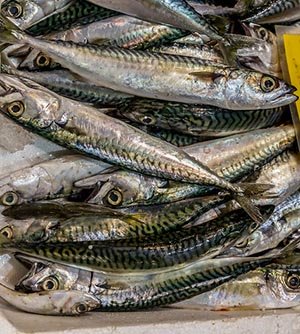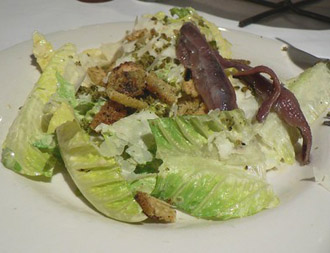Anchovies Nutrition facts
Don't turn away if you come across anchovies in a fish market; despite their diminutive size, anchovies brim with health-benefiting omega-3 fatty acids, calcium, iodine, and selenium.
Anchovies are small, slender, warm-water fish living near coastal areas of all major oceans and seas around the world. Some of the common names of anchovies are California anchovy, pinhead, anchoveta, நெத்திலி மீன், etc. The genus Engraulis includes about nine species.
Scientific name: Engraulis encrasicholus (L.) (Eurpean anchovy), Engraulis capensis (South African anchovy), Stolephorus indicus (Indian anchovy), Engraulis mordax (Californian anchovy), etc.
 |
| Anchovies. Photo courtesy: Marco verch |
Description:
Anchovies are small pelagic fish that feed on small crustaceans (zooplankton). The body is vertically compressed with long snouts that overhang a large, lower-opening mouth. Their dorsal surface is bluish-green and underneath silver gray. They typically grow up to 7 inches in length and weigh about 10 g.
Life cycle:
Anchovies usually spawn throughout the year depending on the region; generally in pelagic waters of coastal areas and estuaries. The lifespan is about 5 years.
Habitat:
Anchovies are often migratory forage fish Estuaries and bays provide important habitat for the northern anchovy, which spends significant time in these habitats. They feed primarily on planktonic crustaceans and fish larvae.
Health Benefits of Anchovies
Anchovies hold 131 calories per 100 g. Despite its small size, anchovy and its products offer unique nutritional and health benefits by having essential fatty acids, protein, minerals, and vitamins.
Being an oily fish, anchovies are an ideal source of vitamin A, vitamin D, and more importantly a unique source long chain omega-3 fatty acids (PUFA).
Its protein is easily digestible and composes all the essential amino acids that favorably complement cereals and legumes protein.
Anchovy's fat tissue composes the highest concentrtion of omega-3s fatty acids; eicosapentaenoicacid (EPA) and docosahexaenoic acid (DHA) for any marine fish. 2.0 oz serving contains 1,200 mg of omega-3s. Research studies suggest that these fatty acids, particularly DHA, play an important role in the development of the neural system, especially in infants and children.
Consumption of anchovy is also known to have health benefits among the adult population. Several large trials have evaluated the effect of fish or fish oils on heart disease. In the "GISSI Prevention Trial, heart attack survivors who took a 1-gram capsule of omega-3 fats every day for three years were less likely to have a repeat heart attack, stroke, or die of sudden death than those who took a placebo".
Anchovies are a small source of vitamin A (50 IU/100 g). vitamin-A and omega-3 are essential for healthy mucosa and skin.
100 g hold 69 IU of vitamin D; about 17% of daily recommended intake. Vitamin D plays an important role in calcium metabolism and offers protection from cancers.
The Food and Drug Administration (FDA) recommends that pregnant women eat at least 8 ounces and up to 12 ounces (340 grams) of a variety of seafood lower in methyl-mercury a week.
Moreover, they are a quintessential source of bone minerals including calcium, phosphorus, and magnesium. In this marine fish, the other trace elements commonly found are selenium and iodine.
| Principle | Nutrient Value | Percent of RDA |
|---|---|---|
| Energy | 131 Kcal | 6.5% |
| Carbohydrates | 0 g | 0% |
| Protein | 20.35 g | 36% |
| Total Fat | 4.84 g | 42% |
| Cholesterol | 0 mg | 0% |
| Dietary Fiber | 0.5 g | 1% |
| Vitamins | ||
| Folates | 9 μg | 2% |
| Niacin | 14.02 mg | 88% |
| Pyridoxine | 0.143 mg | 11% |
| Riboflavin | 0.256 mg | 20% |
| Thiamin | 0.055 mg | 5% |
| Vitamin-A | 50 IU | 1.6% |
| Vitamin-C | 0 mg | 0% |
| Vitamin-D | 69 IU | 17% |
| Vitamin-E | 0.57 mg | 7% |
| Vitamin-K | 0.1 μg | 4% | Electrolytes |
| Sodium | 104 mg | 7% |
| Potassium | 383 mg | 8% |
| Minerals | ||
| Calcium | 147 mg | 15% |
| Iron | 3.25 mg | 40% |
| Magnesium | 41 mg | 10% |
| Phosphorus | 174 mg | 25% |
| Zinc | 1.72 mg | 16% |
| Omega-3 fatty acids (PUFA) | ||
| EPA (20:5 n-3) | 0.538 g | -- |
| DPA (22:5 n-3) | 0.029 g | -- |
| DHA (22:6 n-3) | 0.911 g | -- |
Buying
Anchovies are highly perishable seafood, and hard to find fresh as such in mainland fish markets. Rarely, freshly caught anchovies are sold from coastal fishermen soon after catching them from the ocean.
In many fish markets and supermarkets, they are sold in jars or cans, in the brine, olive-oil or salt. Processed anchovies such as paste, cream, sauce, dip, etc can be readily available in these markets.
Dried anchovies
Boiled and air-dried anchovies can be readily sold in retail stores, especially in Korean groceries. For storage, place them in airtight packs and store them in a cool, dry place for a few weeks.
To prepare at home, place fish in baskets and boil salt water for about 15-20 minutes, until the fish floats. Drain and dry them thoroughly under the sun for 2-3 days to remove moisture before storing.
In the West, salt-packed and oil-packed anchovies sold in cans are a popular way of procuring anchovies. Once opened, keep the unutilized anchovies in the freezer section of the home refrigerator.
Preparation
Fresh caught, small anchovies (7 cm long) need little preparation. In the case of larger ones, remove the head, spine, and innards before employing them in dishes. Wash fish in the water to remove scales and impurities.
Dried anchovies can be directly used for the preparation of stalk/broth. In Asian cuisine, they are employed in deep frying or stir-fries and eaten as snack/side dish.
To desalt brine/salt-packed anchovies, run them carefully under tap water. Steeping in plain water tenderizes them before using them in the dishes. Gentle steeping in milk or wine vinegar for 30-45 minutes enhances their flavor further.
Here are some serving ideas:
 |
| Caesar salad. Photo credit: stu_spivack |
Despite their small size, anchovies are still appreciated in many traditions as popular seafood. In the Mediterranean, they employed in several dishes.
Anchovies, along with fried onions and olives, are employed as toppings in the popular Southern French appetizer caramelized onion and anchovy tart-Pissaladiere.
In France, anchovies, along with capers and olives, are one of the popular ingredients in the preparation of condiment dip called "tapenade".
In Japan and Korea, dried anchovies are common to prepare dashi (stock) in traditional households. Its essence flavors soups and sauces.
In Korean cooking, stir-fried dried anchovies (멸치볶음) with shishito peppers is a popular snack enjoyed as is or with boiled rice.
In the coastal part of southern Indian state, Tamilnadu- nethili meen curry (நெத்திலி மீன் குழம்பு-anchovy fish curry) served over rice is a popular dish.
Safety profile
Being a small, fatty fish, anchovies contain traces of heavy metals and dioxins (Polychlorinated dibenzodioxins (PCDDs)), unlike other large fish like tuna and considered safe to eat up to 12 ounces (2 average meals) a week.
However, if your anchovies are from pelagic waters, where the risks of exposure to these compounds are high due to environmental pollution, pay attention to local advisories. If advice isn't available, limit its consumption to 6 ounces (170 grams) a week.
Anchovies are low in mercury and high in omega-3 fatty acids. WHO's tolerable upper limit of mercury in food is 0.5 mg/kg of fish. The mean mercury concentration in anchovies is 0.016 PPM; in comparison, tuna holds 0.144 PPM; 9 times more. (Medical disclaimer).
Also read ≻≻-
≺≺- Mercury in Fish: Health Benefits, Risks, and Safe Choices
≺≺- Salmon nutrition facts and health benefits.
≺≺- Sardines nutrition facts and health benefits.
<<-Back to Seafood from Anchovies Nutrition Facts and Health Benefits.
Further reading (Links opens in new window):
Omega-3 Fatty Acids: An Essential Contribution.